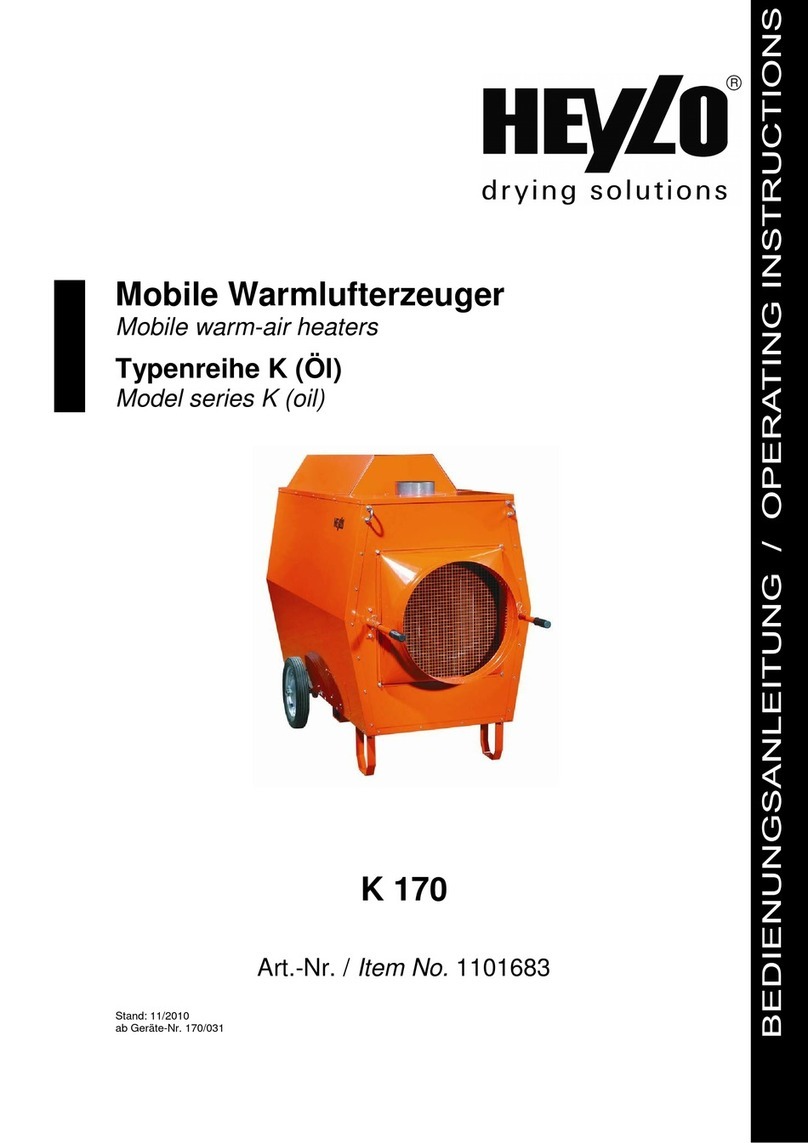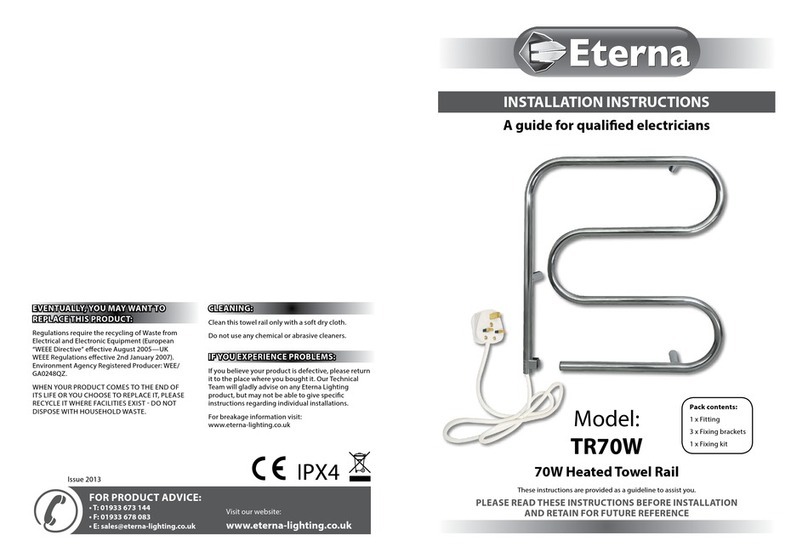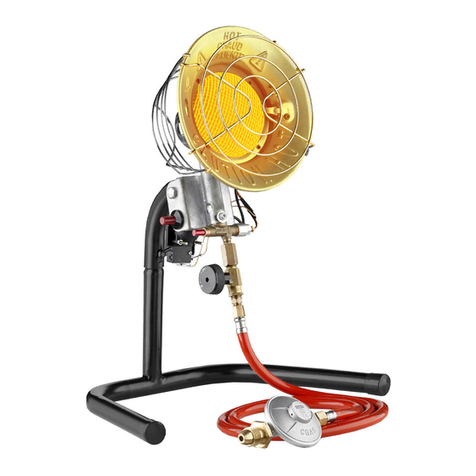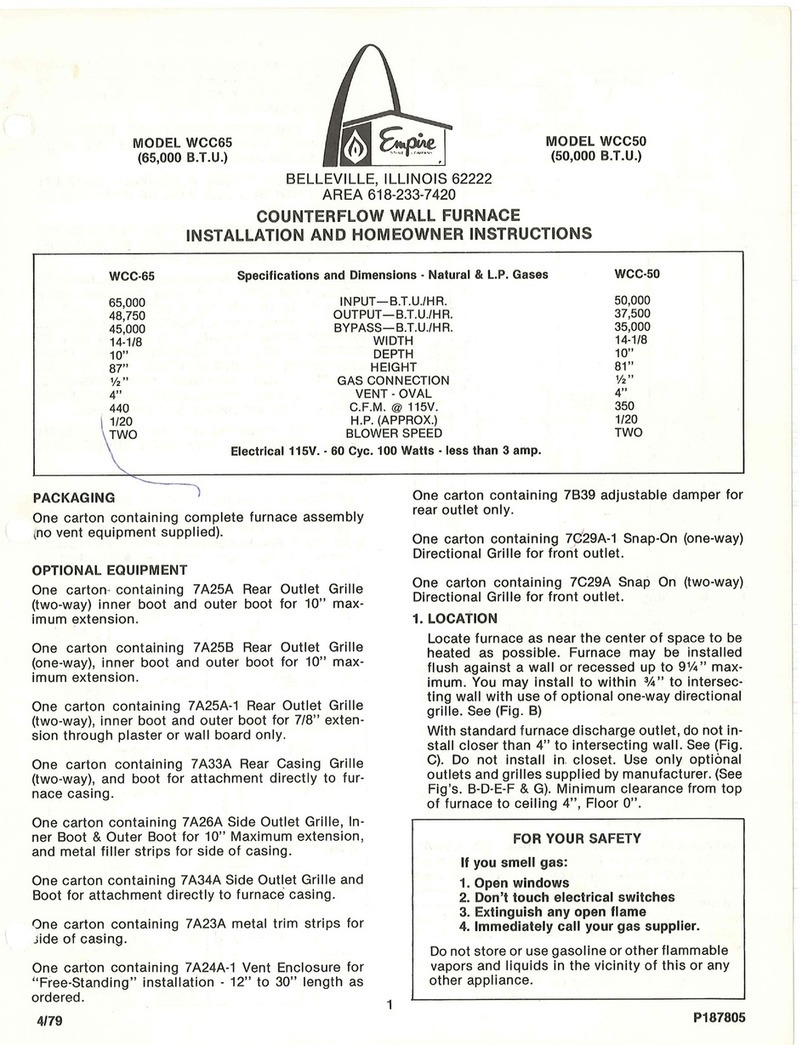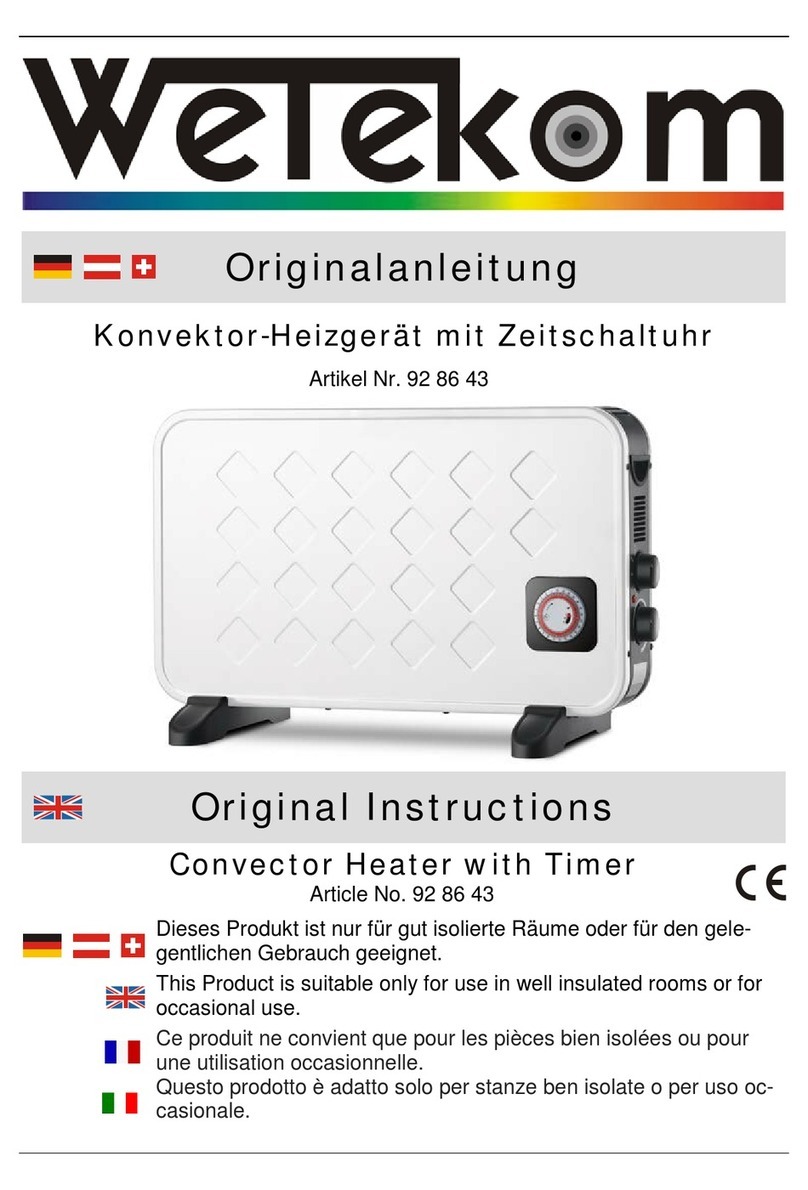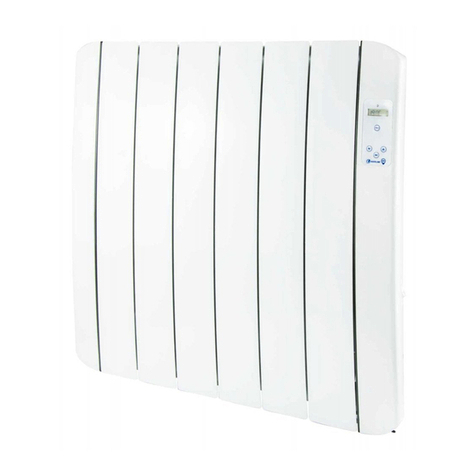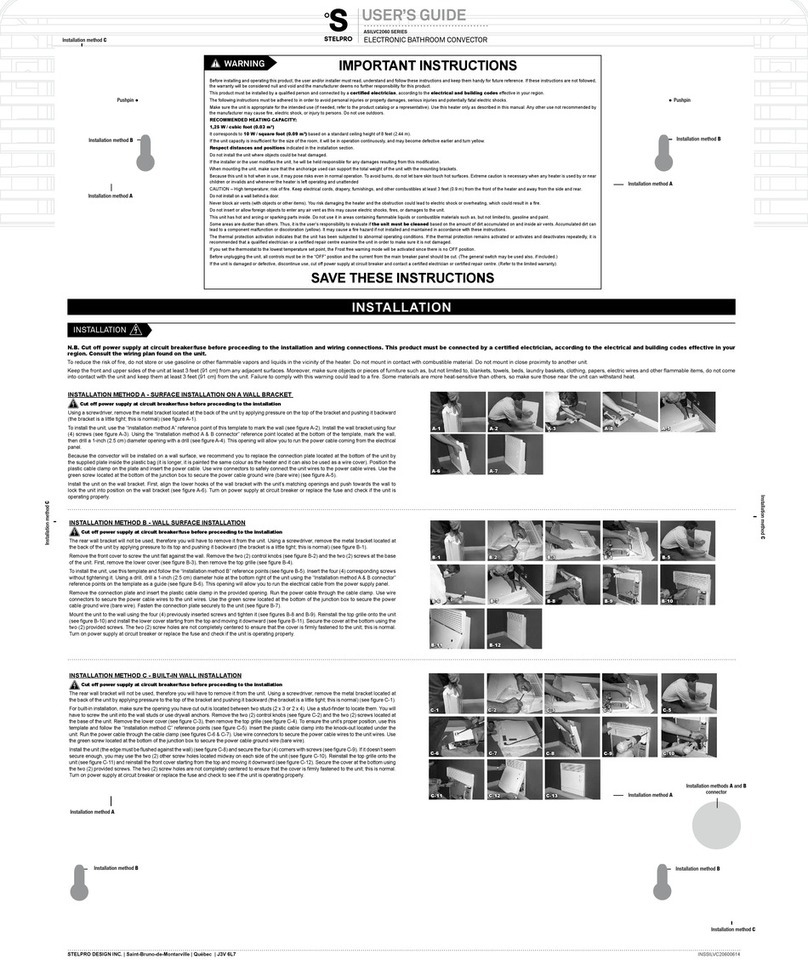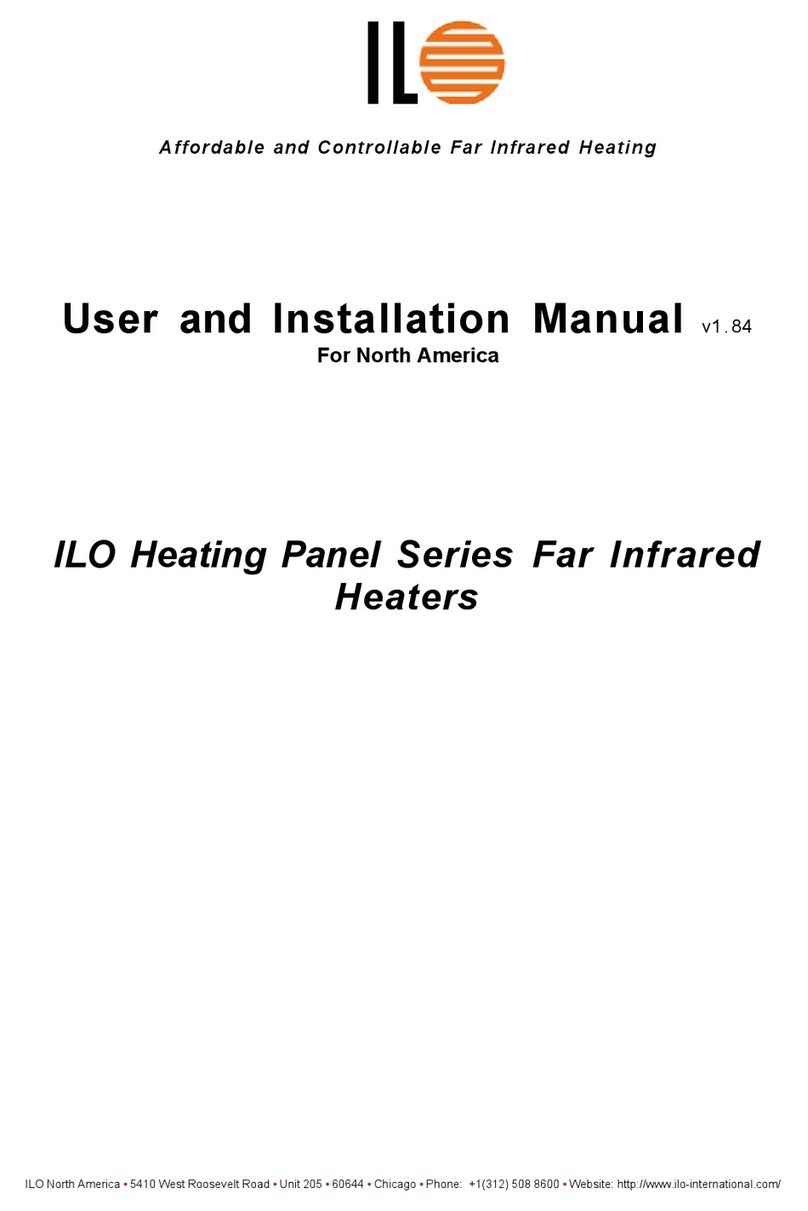
NOTE: DIAGRAMS & ILLUSTRATION NOT TO SCALE. 3
•Do not install the heater in a bedroom or
bathroom.
•The installation must conform with local
codes or, in the absence of local codes with the
National Fuel Gas Code, ANSI Z223.1.
•The heater and its individual shut-off valve
must be disconnected from the gas supply
pipingsystemwhileperformingany testsofthe
gas supply piping system at pressures in ex-
cess of 1/2 psig.
•The heater must be isolated from the gas
supply piping system by closing its individual
manualshut-offvalve duringanypressuretest-
ing of the gas supply piping system at test
pressures equal to or less than 1/2 psig.
•Keep heater area clear and free from com-
bustible materials, gasoline and other flam-
mable vapors and liquids.
•Do not use this heater if any part has been
under water. Immediately call a qualified ser-
vice technician to inspect the room heater and
to replace any part of the control system and
any gas control which has been under water.
•Input ratings are shown in BTU per hour and
arefor elevationsupto 4,800feet.Do notinstall
thisheateratanelevationabove4,800feetifthe
gas supply has not been derated for that eleva-
tion. Consult your local gas supplier. (For op-
eration at elevations above 4,800 feet, equip-
ment ratings shall be reduced at the rate of 4
percent for each 1,000 feet above sea level
beforeselectingappropriatelysizedequipment.)
•Ensure that the heater is clean when operat-
ing.Excessivedustaccumulationon theburner
and/or logs will increase the amount of carbon
monoxide formation and could lead to carbon
monoxide poisoning and/or death.
CODES
Adhere to all local codes or in their absence the
latest edition of The National Fuel Gas Code
ANSI Z223.1 or NFPA54 which can be obtained
from The American National Standards Insti-
tute, Inc. (1430 Broadway, New York, NY,
10018)orNational Fire ProtectionAssociation,
Inc. (Batterymarch Park, Quincy, MA, 02269).
Stateorlocal codesmayonly allowoperationof
thisappliance(manualversiononly)inavented
configuration. Check your state or local codes.
Seller of unvented propane or natural gas-
fired supplemental room heaters shall provide
to each purchaser a copy of 527 CMR 30 upon
sale of the unit.
Superior Unvented Gas Log Room Heaters are
certified by OMNI to ANSI Z21.11.2 standard.
These gas log room heaters may be used as a
spaceheat sourcefora roominconjunction with
an approved unvented firebox. Additionally,
manually controlled units are design certified by
OMNI to ANSI 21.60 as a vented gas log set.
Assuch,manuallycontrolledunitsmaybeused
as a vented gas log set in any wood-burning
fireplace that has been properly constructed to
code, and in the case of factory built fireplaces,
installedincompliancewithmanufacturerslist-
ing and installation instruction.
Useofthe manuallycontrolled logsetscovered
by this manual in a properly vented wood-
burning fireplace which has had the damper
blocked open as detailed in these installation
instructionsprecludeconsiderationofthecom-
bustion and ventilation air and clearance to
combustible restrictions discussed herein.
COMBUSTION AND VENTILATION AIR
These heaters shall not be installed in a con-
fined space. The heater may be located in
unusually tight construction provided the
space is unconfined, or if confined, is pro-
vided with two permanent openings commu-
nicating directly with an additional room(s)
of sufficient volume so that the combined
volume of all connected spaces meets the
criteria for an unconfined space, (National
Fuel Gas Code ANSI Z223.1 (latest edition),
Section 5.3). Generally 50 ft 3per 1,000 BTU
input of all operating appliances in the space.
The National Fuel Gas Code defines a con-
fined space as a space whose volume is less
than 50 ft 3per 1,000 BTU/Hr (4.8 m3per kw)
of the aggregate input rating of all appliances
installed in that space and an unconfined
space as a space whose volume is not less
than 50 ft 3per 1,000 BTU/Hr (4.8 m3per kw)
of the aggregate input rating of all appliances
installed in that space. Rooms communicat-
ing directly with the space in which the appli-
ances are installed, through openings not
furnishedwithdoors, areconsidered a partof
the unconfined space.
Unusually tight construction is defined as
construction where:
a. wall and ceilings exposed to the outside
atmosphere have a continuous water vapor
retarder with a rating or one perm or less with
openings gasketed or sealed, and
b. weather stripping has been added on oper-
able windows and doors, and
c.caulkingorsealantsareappliedtoareassuch
as joints around window and door frames,
between sole plates and floors, between wall-
ceiling joints, between wall panels, at penetra-
tions for plumbing, electrical, and gas lines,
and at other openings.
Use the following equations to determine if you
have a confined or unconfined space.
1. Determine the volume of space — ft 3.
Length x Width x Height = _____ ft 3
(Include adjoining rooms with doorless pas-
sageways or ventilation grills between
rooms.)
Example:24' (L)x16'(W)x 8'(H)= 3072ft 3
2. Divide the volume of space by 50 ft 3to
determine the maximum BTU/Hr the space
can support.
______ (volume of space – ft 3)/ 50 ft 3=
(Maximum BTU/Hr the space can support)
Example: 3072 ft 3/ 50 ft 3= 61.44
or 61,440 BTU/Hr the space can support.
3. Add the BTU/Hr of all the fuel burning appli-
ances in the space.
Vent-Free heater _______ BTU/Hr
Gas appliance #1* _______ BTU/Hr
Gas appliance #2 + _______ BTU/Hr
Total = _______ BTU/Hr
Example:
Vent-free heater 32,000 BTU/Hr
Gas appliance #1 35,000 BTU/Hr
(water heater) Total = 67,000 BTU/Hr
* Do not include direct-vent gas appliances.
Direct-vent is sealed combustion and draws
combustion air from the outdoors.
4. Compare the maximum BTU/Hr the space
can support with the actual amount of BTU/
Hr used.
_________ BTU/Hr
(max. the space can support)
_________ BTU/Hr
(actualamountofBTU/Hrused)
Example:
61,440 BTU/Hr
(max. the space can support)
67,000 BTU/Hr
(actualamountofBTU/Hrused)








